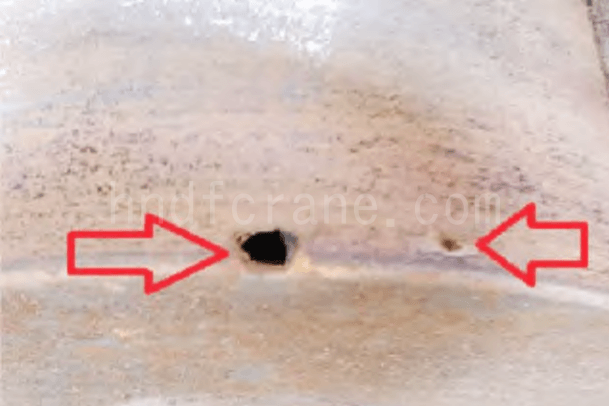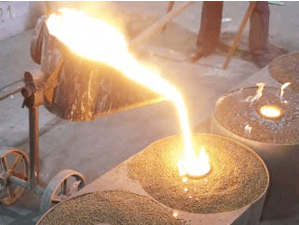Overhead Crane Brake Wheels Failure: Circular Surface Defects Causes and Treatment
Table of Contents

As a key equipment in industrial production, the safety and reliability of overhead cranes directly affect production efficiency and operation safety.
The overhead crane brake wheel is an important part of the overhead crane. It undergoes high-intensity friction and pressure during the braking process, so it is prone to various defects, which affect the normal operation and service life of the crane.
With the widespread application of overhead cranes in various harsh environments, the frequency of failure of brake wheels has gradually increased, especially the emergence of circular defects, which has brought serious challenges to the safe operation of equipment. However, most of the existing research focuses on common defects of As a key equipment in industrial production, the safety and reliability of overhead cranes directly affect production efficiency and operation safety.
The overhead crane brake wheel is an important part of the overhead crane brake wheels, such as surface cracks and wear, while relatively little research has been done on the circular defects on the surface of the overhead crane brake wheels and their causes. This article will analyze the circular defects of the brake wheels of overhead cranes, explore the specific causes, and propose effective treatment measures and prevention strategies.
Through a comprehensive discussion of the casting process, heat treatment process, and operating environment, it provides practical guidance on the reliability of the overhead crane brake wheels.
Overhead cranes brake wheels main defects and analysis
Influence of environmental factors on overhead cranes
First, overhead cranes usually operate in environments with more dust and metal impurities. Impurities can easily enter the interior of the machinery, thereby increasing the wear and tear of parts. In the long run, the failure rate will increase, the safety performance of use will decrease, and the life span will be significantly reduced.
Secondly, the influence of the size and nature of the crane’s working load on the crane, in normal operations, when the load on the parts is greater than the average design load, will intensify the wear of the brake tiles and overhead crane brake wheels. Long-term high-load operations will affect the service life of the crane. Practice has shown that stable loads have less wear and tear, fewer failures, and longer life spans.
Defects in overhead crane brake wheels
The overhead crane brake wheels are composed of multiple casting parts. The defects that occur in the casting process are inevitably reflected in the brake wheel, which is mainly manifested in the following aspects:
- It is manifested on the outside of the forging, such as rough external surfaces, pits, creases, unfilled, folds, cracks, etc.
- Some will appear internally, such as looseness, cracks, coarse crystals, hair lines, white spots, segregation, inclusions, surface decarbonization, dendritic crystals, coarse crystal rings, shrinkage remnants, non-ferrous metal penetration, oxide film, streamline disorders, etc.
- Some are reflected in the microstructure, such as the precipitation of the second phase.
- Some are reflected in the performance of forgings, such as unqualified room temperature strength or plasticity, toughness, fatigue properties, etc., instantaneous strength, long-lasting strength, long-lasting plasticity, creep strength, and other high-temperature properties or hot and cold fatigue properties do not meet the requirements of use. Whether it is the surface quality problems of crane wheel forgings or internal performance defects, they usually affect each other, are often closely connected, accompany each other, and form a vicious circle.
Discovery of defects in overhead crane brake wheels
Due to its frequent use and large load fluctuations, overhead cranes often experience start-up and braking cycles in their various mechanisms. Within a specific period, when braking operations need to be performed, their braking performance is often not ideal. At the same time, many crane operators lack professional and skilled operating skills.
During the operation process, they often tilt the crane obliquely, and the lifting cargo is not at the plumb point of the lifting point; before the crane lifting point is in place, they rely on reversing the vehicle to achieve the purpose of braking in place. In addition, during the work of the crane, there is frequent friction between the brake tile and the brake wheel, and the brake tile is worn to a certain extent, causing the overhead crane brake wheels to reveal deep slag-trapping circular defects.
When a sharp hammer is used to hit the pit of the overhead crane brake wheels, the sound of sand crushing can be heard, which shows that the material of the overhead crane brake wheels is broken and hard, and there is a tendency for slag to exist in the black circular defects on the surface.
During the regular inspection of the overhead crane, it was found that the components of the lifting and operating structure system made abnormal noises during operation, and the careful inspection found that there were some circular defects on the surface of the overhead crane brake wheel. The inner walls of these defects are rough and dark brown. The diameter of the defects is 7mm and 3mm, and the depth is 12mm and 5mm, respectively, as shown in the figure.

Causes of overhead crane brake wheels defects
- During the casting process of the overhead crane brake wheels, the liquid steel degassing is insufficient, the liquid steel deoxygenation is insufficient during the smelting process, and the liquid steel contains too much gas, as shown in the figure. Therefore, the degree of local shrinkage caused by “supercooling” is often too large, which makes the brake wheel itself cast unevenly and forms air bubbles.
- There is residue in the mold cavity, and the exhaust of the cavity is not smooth during perfusion; sand particles or other debris fall into the mold during the perfusion process, so the parts of the cast steel parts are not fully filled. Due to the presence of voids inside the object, when shrinking, the epidermis layer still has a certain hardness due to the cooling effect of natural temperature, but it will form a depression on the surface due to the internal shrinkage effect.
- During the casting process, the gas is sandwiched between the metal flow and the cavity wall and cannot be completely discharged, thus forming air bubbles in the corresponding parts of the brake wheel. If these air bubbles gather in large quantities in the cavity, they will appear on the edges and surface parts of the cast steel.

After the above analysis, it can be seen that the material, casting process, and factors in the use process will cause significant tensile stress and compressive stress in the stress concentration area on the contact surface of the brake tile and the overhead crane brake wheels. These stresses exceed the limit of the elastic strength of the castings, coupled with improper operation and frequent friction, which exposes deep slag-trapping circular defects.
Treatment measures
Control the quality of the overhead crane brake wheels
To improve the service life and performance of crane brake wheels, it is necessary to control the quality and performance in the manufacturing process and to strengthen quality control in production technology. In the manufacturing process of overhead crane brake wheels, its process and production technology should strictly follow the process of casting→ normalizing→machining → intermediate frequency quenching, and tempering→ grinding.
Among them, the normalizing temperature should be controlled at about 830℃, which can be completed in a 100kW trolley-type resistance furnace, and the insulation time should be controlled within 1h; the tempering temperature should be controlled at about 350℃, which can be completed in a 95kW well-type resistance furnace, and the tempering time should be controlled within 1h.
During the heat treatment process of the overhead crane brake wheels, the surface hardness of the material heat treatment should be controlled at 3545HR, and the depth of the hardened layer should be controlled at 23mm. This can improve the hardness and wear resistance of the overhead crane brake wheels, as well as the elastic limit and comprehensive mechanical properties of the steel, thereby improving the material properties or chemical properties of the steel.
Adjust the gap between the overhead crane brake wheels and the brake tile
The gap between the brake tile of the crane and the overhead crane brake wheels determines the braking performance of the brake wheel to a certain extent. When the gap between the brake wheel and the brake tile is small, serious friction will form between the two during the frequent work of the crane brake wheel. When the material on the surface of the brake tile is crushed by friction, the bolts used to fix the brake tile will directly rub against the overhead crane brake wheel.
The damage caused by this friction to the brake wheel is extremely serious, so the crane operator must strictly check the gap between the crane brake wheel and the brake tile. Once it is found that the gap between the two is too small, it should be adjusted to the appropriate standard immediately to ensure normal operation.
Strengthen inspection
The brake wheel is one of the most prone parts of the crane’s work process. Therefore, the operator should regularly inspect the brake wheel during the normal use of the crane. The inspection content mainly includes the following aspects:
- Conduct a detailed measurement of the gap between the brake wheel and the brake tile to ensure that the gap between the brake wheel and the brake tile is kept within a scientific and reasonable range during the work process.
- In the process of operating the crane, pay attention to whether the sound of the brake wheel during operation is normal.
- Regularly inspect and maintain the brake wheels, scientifically evaluate and reasonably predict the wear and tear, and check the surface of the brake wheels for defects that affect safety.
- Check the compression spring of the brake brake tile. If the spring elasticity is found to be insufficient, it should be replaced immediately.
Safety technical inspection
When inspecting the brake wheels of the bridge crane, the following steps should be followed:
- For each shift, it should be carefully checked once.
- The inspector can use a measuring tape to measure the amount of clearance on both sides of the brake wheel, and it should meet the requirements of national standards.
- You can use a vernier caliper to measure the rim thickness of the brake wheel. It is required that the diameter of the rim of the brake wheel before wear is an integer value, to quickly and accurately calculate the original thickness of the rim of the brake wheel, and then calculate the thickness of the wear.
- Ensure that the friction surface of the brake wheel is clean. If oil and other dirt are found, they should be cleaned immediately.
During the inspection of bridge cranes, the following precautions should be strictly observed.
- During the inspection process, the inspectors shall strictly inspect the components one by one by the provisions of TSG 51-2023 “Special Equipment Safety Technical Specifications”.
- During the inspection process of bridge cranes, the defects found and the main geometric dimensions should be recorded or photographed in detail so that they can be compared in a targeted manner in future inspections.
- During the inspection of parts and various performance tests, listen carefully to see if there is abnormal sound during the operation of the crane; take a closer look to see if there are obvious deformation, wear, pits, and other defects in the moving parts; carefully measure the data and make a record.
- Ensure that the problems found during the inspection and testing process are notified to the user unit on time, and provide detailed explanations, rectification opinions, and suggestions.
Summary
The circular defect of the brake wheel of the overhead crane is an important issue that affects the safe operation and life of the equipment. Through the analysis of the causes of brake wheel defects and the discussion of treatment measures, the article proposes the following three targeted improvement plans:
- Improvement of casting process: The brake wheel needs to strictly control the degassing and deoxygenation process of liquid steel during the casting process, reduce the generation of air bubbles and slag, and avoid the formation of circular surface defects from the source.
- Heat treatment optimization: Through a reasonable heat treatment process, the hardness and wear resistance of the brake wheel material are improved, its performance in high stress and high temperature environments is enhanced, and its service life is extended.
- Operation and maintenance specifications: strengthen the daily inspection and maintenance of the brake wheel, especially the adjustment of the gap between the brake wheel and the brake tile, reduce unnecessary wear and stress concentration, and ensure the safe operation of the crane.
Send Your Inquiry
- Email: sales@hndfcrane.com
- WhatsApp: +86-191 3738 6654
- Tel: +86-373-581 8299
- Fax: +86-373-215 7000
- Add: Changnao Industrial District, Xinxiang City, Henan Province, China








































































